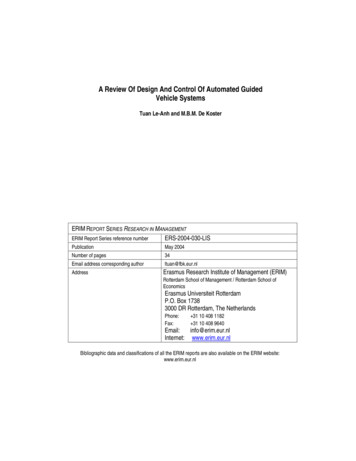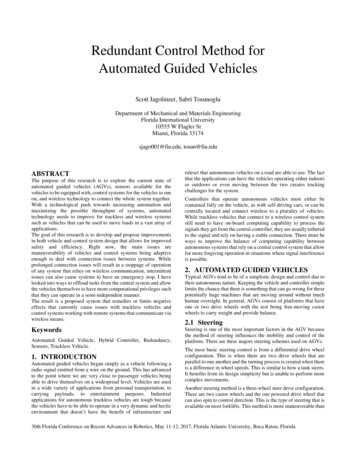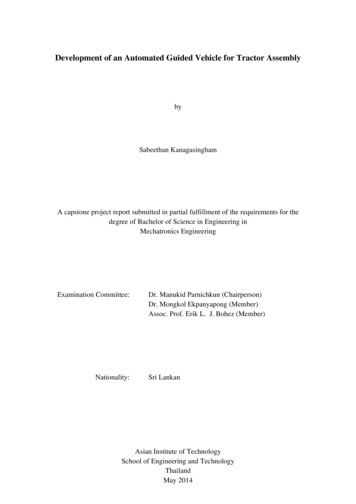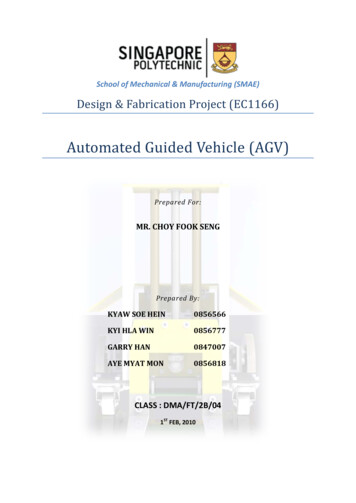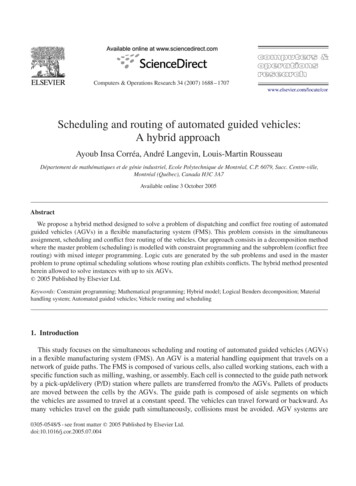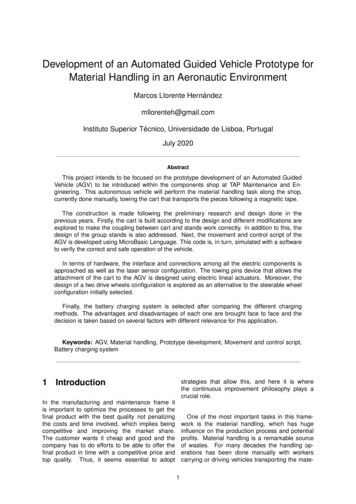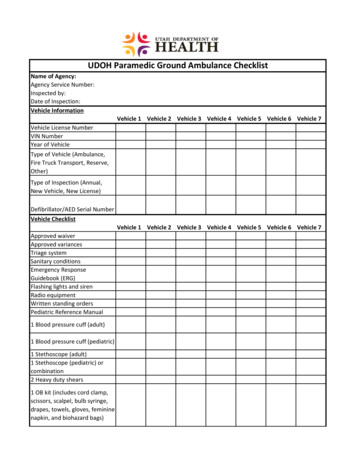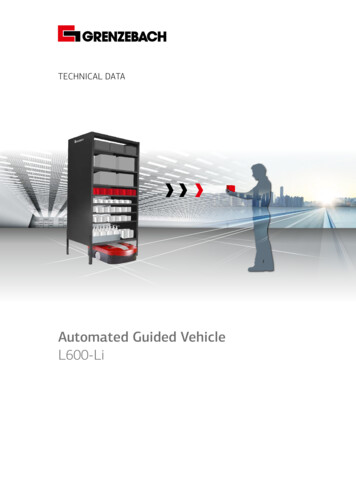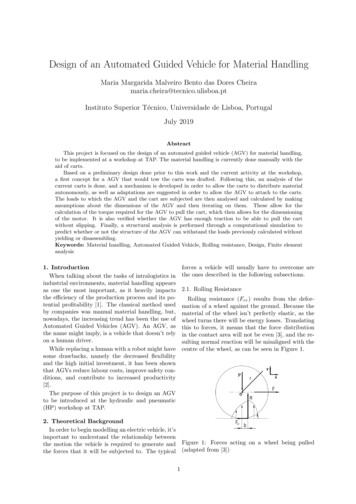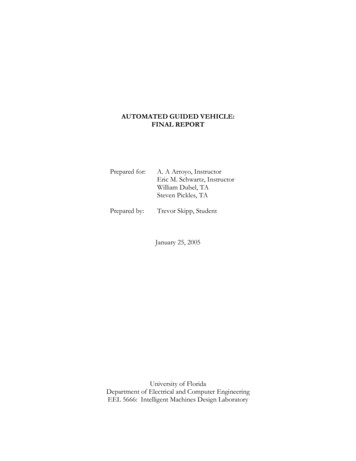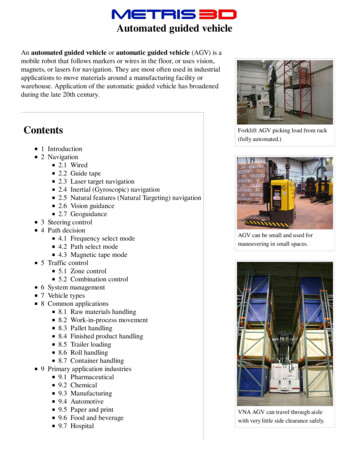
Transcription
Automated guided vehicleAn automated guided vehicle or automatic guided vehicle (AGV) is amobile robot that follows markers or wires in the floor, or uses vision,magnets, or lasers for navigation. They are most often used in industrialapplications to move materials around a manufacturing facility orwarehouse. Application of the automatic guided vehicle has broadenedduring the late 20th century.Contents1 Introduction2 Navigation2.1 Wired2.2 Guide tape2.3 Laser target navigation2.4 Inertial (Gyroscopic) navigation2.5 Natural features (Natural Targeting) navigation2.6 Vision guidance2.7 Geoguidance3 Steering control4 Path decision4.1 Frequency select mode4.2 Path select mode4.3 Magnetic tape mode5 Traffic control5.1 Zone control5.2 Combination control6 System management7 Vehicle types8 Common applications8.1 Raw materials handling8.2 Work-in-process movement8.3 Pallet handling8.4 Finished product handling8.5 Trailer loading8.6 Roll handling8.7 Container handling9 Primary application industries9.1 Pharmaceutical9.2 Chemical9.3 Manufacturing9.4 Automotive9.5 Paper and print9.6 Food and beverage9.7 HospitalForklift AGV picking load from rack(fully automated.)AGV can be small and used formaneuvering in small spaces.VNA AGV can travel through aislewith very little side clearance safely.
9.8 Warehousing9.9 Theme parks10 Battery charging10.1 Battery swap10.2 Automatic and opportunity charging10.3 Automatic battery swap11 See also12 ReferencesIntroductionThe AGV can tow objects behind them in trailers to which they canautonomously attach. The trailers can be used to move raw materials orfinished product. The AGV can also store objects on a bed. The objectscan be placed on a set of motorized rollers (conveyor) and then pushedoff by reversing them. AGVs are employed in nearly every industry,including, pulp, paper, metals, newspaper, and general manufacturing.Transporting materials such as food, linen or medicine in hospitals is alsodone.Side Clamp AGVs can pickunpalletized loads.An AGV can also be called a laser guided vehicle (LGV). In Germanythe technology is also called Fahrerlose Transportsysteme (FTS) and inSweden förarlösa truckar. Lower cost versions of AGVs are oftencalled Automated Guided Carts (AGCs) and are usually guided bymagnetic tape. AGCs are available in a variety of models and can beused to move products on an assembly line, transport goods throughout aplant or warehouse, and deliver loads.The first AGV was brought to market in the 1950s, by BarrettElectronics of Northbrook, Illinois, and at the time it was simply a towtruck that followed a wire in the floor instead of a rail. In 1976, EgeminAutomation (Holland, MI) started working on the development of anautomatic driverless control system for use in several industrial andcommercial applications. Out of this technology came a new type ofAGV, which follows invisible UV markers on the floor instead of beingtowed by a chain. The first such system was deployed at the WillisTower (formerly Sears Tower) in Chicago, Illinois to deliver mailthroughout its offices.AGV can have both manual andautomated control.Over the years the technology has become more sophisticated and todayautomated vehicles are mainly Laser navigated e.g. LGV (Laser GuidedVehicle). In an automated process, LGVs are programmed toAGVs can be programmed to do acommunicate with other robots to ensure product is moved smoothlywide variety of tasks.through the warehouse, whether it is being stored for future use or sentdirectly to shipping areas. Today, the AGV plays an important role in thedesign of new factories and warehouses, safely moving goods to their rightful destination.Navigation
3 of 13WiredA slot is cut in to the floor and a wire is placed approximately 1 inchbelow the surface. This slot is cut along the path the AGV is to follow.This wire is used to transmit a radio signal. A sensor is installed on thebottom of the AGV close to the ground. The sensor detects the relativeposition of the radio signal being transmitted from the wire. Thisinformation is used to regulate the steering circuit, making the AGVfollow the wire.AGV for carrying explosives.Guide tapeAGVs (some known as automated guided carts or AGCs) use tape forthe guide path. The tapes can be one of two styles: magnetic or colored.The AGC is fitted with the appropriate guide sensor to follow the path ofthe tape. One major advantage of tape over wired guidance is that it canbe easily removed and relocated if the course needs to change. Coloredtape is initially less expensive, but lacks the advantage of beingembedded in high traffic areas where the tape may become damaged ordirty. A flexible magnetic bar can also be embedded in the floor like wirebut works under the same provision as magnetic tape and so remainsunpowered or passive. Another advantage of magnetic guide tape is thedual polarity. small pieces of magnetic tape may be placed to changestates of the AGC based on polarity and sequence of the tags.Flat AGV for carrying very heavycargo.Laser target navigationThe navigation is done by mounting reflective tape on walls, poles orfixed machines. The AGV carries a laser transmitter and receiver on arotating turret. The laser is transmitted and received by the same sensor.The angle and (sometimes) distance to any reflectors that in line of sightand in range are automatically calculated. This information is comparedto the map of the reflector layout stored in the AGV's memory. Thisallows the navigation system to triangulate the current position of theAGV. The current position is compared to the path programmed in to thereflector layout map. The steering is adjusted accordingly to keep theAGV on track. It can then navigate to a desired target using theconstantly updating position.Curved clamps allow this type ofclamp AGV to pick rolls of paper andmove them to production areas.Modulated Lasers The use of modulated laser light gives greaterrange and accuracy over pulsed laser systems. By emitting acontinuous fan of modulated laser light a system can obtain anuninterrupted reflection as soon as the scanner achieves line ofPackmobile with trailer AGVsight with a reflector. The reflection ceases at the trailing edge ofthe reflector which ensures an accurate and consistentmeasurement from every reflector on every scan. By using a modulated laser a system can achieve anangular resolution of 0.1 mrad (0.006 ) at 8 scanner revolutions per second.Pulsed Lasers A typical pulsed laser scanner emits pulsed laser light at a rate of 14,400 Hz which gives amaximum possible resolution of 3.5 mrad (0.2 ) at 8 scanner revolutions per second. To achieve aworkable navigation, the readings must be interpolated based on the intensity of the reflected laser light,
to identify the centre of the reflector.Inertial (Gyroscopic) navigationAnother form of an AGV guidance is inertial navigation. With inertial guidance, a computer control systemdirects and assigns tasks to the vehicles. Transponders are embedded in the floor of the work place. The AGVuses these transponders to verify that the vehicle is on course. A gyroscope is able to detect the slightest changein the direction of the vehicle and corrects it in order to keep the AGV on its path. The margin of error for theinertial method is 1 inch.[1]Inertial can operate in nearly any environment including tight aisles or extreme temperatures.[2] Inertialnavigation can include use of magnets embedded in the floor of the facility that the vehicle can read andfollow.[3]Natural features (Natural Targeting) navigationNavigation without retrofitting of the workspace is called Natural Features orNatural Targeting Navigation. One method uses one or more range-findingsensors, such as a laser range-finder, as well as gyroscopes or inertialmeasurement units with Monte-Carlo/Markov localization techniques tounderstand where it is as it dynamically plans the shortest permitted path to itsgoal. The advantage of such systems is that they are highly flexible foron-demand delivery to any location. They can handle failure without bringingdown the entire manufacturing operation, since AGVs can plan paths around thefailed device. They also are quick to install, with less down-time for thefactory.[4]Vision guidance[1](http://www.mobilerobots.com) Unit-load AGV usingnatural-features navigation tocarry steel to quality assurancelabVision-Guided AGVs can be installed with no modifications to the environmentor infrastructure. They operate by using cameras to record features along theroute, allowing the AGV to replay the route by using the recorded features tonavigate. Vision-Guided AGVs use Evidence Grid technology, an application ofprobabilistic volumetric sensing, and was invented and initially developed by Dr.Moravec at Carnegie Mellon University. The Evidence Grid technology usesprobabilities of occupancy for each point in space to compensate for the uncertainty in the performance ofsensors and in the environment. The primary navigation sensors are specially designed stereo cameras. Thevision-guided AGV uses 360-degree images and build a 3D map, which allows the vision-guided AGVs to followa trained route without human assistance or the addition of special features, landmarks or positioning systems.GeoguidanceA geoguided AGV recognizes its environment to establish its location. Without any infrastructure, the forkliftequipped with geoguidance technology detects and identifies columns, racks and walls within the warehouse.Using these fixed references, it can position itself, in real time and determine its route. There are no limitationson distances to cover or number of pick-up or drop-off locations. Routes are infinitely modifiable.Steering control
To help an AGV navigate it can use three different steer control systems.[5] The differential speed control is themost common. In this method there are two independent drive wheels. Each drive is driven at different speeds inorder to turn or the same speed to allow the AGV to go forwards or backwards. The AGV turns in a similarfashion to a tank. This method of steering is the simplest as it does not require additional steering motors andmechanism. More often than not, this is seen on an AGV that is used to transport and turn in tight spaces orwhen the AGV is working near machines. This setup for the wheels is not used in towing applications becausethe AGV would cause the trailer to jackknife when it turned.The second type of steering used is steered wheel control AGV. This type of steering can be similar to a carssteering. But this is not very manoeuvrable. It is more common to use a three-wheeled vehicle similar to aconventional three wheeled forklift. The drive wheel is the turning wheel. It is more precise in following theprogrammed path than the differential speed controlled method. This type of AGV has smoother turning.Steered wheel control AGV can be used in all applications; unlike the differential controlled.[1] Steered wheelcontrol is used for towing and can also at times have an operator control it.The third type is a combination of differential and steered. Two independent steer/drive motors are placed ondiagonal corners of the AGV and swivelling castors are placed on the other corners. It can turn like a car(rotating in an arc) in any direction. It can crab in any direction and it can drive in differential mode in anydirection.Path decisionAGVs have to make decisions on path selection. This is done through different methods: frequency select mode(wired navigation only), and path select mode (wireless navigation only) or via a magnetic tape on the floor notonly to guide the AGV but also to issue steering commands and speed commands.Frequency select modeFrequency select mode bases its decision on the frequencies being emitted from the floor. When an AGVapproaches a point on the wire which splits the AGV detects the two frequencies and through a table stored inits memory decides on the best path. The different frequencies are required only at the decision point for theAGV. The frequencies can change back to one set signal after this point. This method is not easily expandableand requires extra cutting meaning more money.Path select modeAn AGV using the path select mode chooses a path based on preprogrammed paths. It uses the measurementstaken from the sensors and compares them to values given to them by programmers. When an AGV approachesa decision point it only has to decide whether to follow path 1, 2, 3, etc. This decision is rather simple since italready knows its path from its programming. This method can increase the cost of an AGV because it isrequired to have a team of programmers to program the AGV with the correct paths and change the paths whennecessary. This method is easy to change and set up.Magnetic tape modeThe magnetic tape is laid on the surface of the floor or buried in a 10mm channel; not only does it provide thepath for the AGV to follow but also strips of the tape in different combos of polarity, sequence, and distance laidalongside the track tell the AGV to change lane, speed up, slow down, and stop.
Traffic controlFlexible manufacturing systems containing more than one AGV may require it to have traffic control so theAGV’s will not run into one another. Traffic control can be carried out locally or by software running on a fixedcomputer elsewhere in the facility. Local methods include zone control, forward sensing control, andcombination control. Each method has its advantages and disadvantages.[6]Zone controlZone control is the favorite of most environments because it is simple to install and easy to expand.[1] Zonecontrol uses a wireless transmitter to transmit a signal in a fixed area. Each AGV contains a sensing device toreceive this signal and transmit back to the transmitter. If the area is clear the signal is set at “clear” allowingany AGV to enter and pass through the area. When an AGV is in the area the “stop” signal is sent and all AGVattempting to enter the area stop and wait for their turn. Once the AGV in the zone has moved out beyond thezone the “clear” signal is sent to one of the waiting AGVs. Another way to set up zone control trafficmanagement is to equip each individual robot with its own small transmitter/receiver. The individual AGV thensends its own “do not enter” message to all the AGVs getting to close to its zone in the area. A problem with thismethod is if one zone goes down all the AGV’s are at risk to collide with any other AGV. Zone control is a costefficient way to control the AGV in an area.Forward sensing control uses collision avoidance sensors to avoidcollisions with other AGV in the area. These sensors include: sonic,which work like radar; optical, which uses an infrared sensor; andbumper, physical contact sensor. Most AGVs are equipped with abumper sensor of some sort as a fail safe. Sonic sensors send a “chirp” orhigh frequency signal out and then wait for a reply from the outline ofthe reply the AGV can determine if an object is ahead of it and take thenecessary actions to avoid collision.[7] The optical uses an infraredtransmitter/receiver and sends an infrared signal which then getsreflected back; working on a similar concept as the sonic sensor. Theproblems with these are they can only protect the AGV from so manysides. They are relatively hard to install and work with as well.Forklift AGV with safety laser sensors.(fully automated.)Combination controlCombination control sensing is using collision avoidance sensors as well as the zone control sensors. Thecombination of the two helps to prevent collisions in any situation. For normal operation the zone control is usedwith the collision avoidance as a fail safe. For example, if the zone control system is down, the collisionavoidance system would prevent the AGV from colliding.System managementIndustries with AGVs need to have some sort of control over the AGVs. There are three main ways to controlthe AGV: locator panel, CRT color graphics display, and central logging and report.[1]A locator panel is a simple panel used to see which area the AGV is in. If the AGV is in one area for too long, itcould mean it is stuck or broken down. CRT color graphics display shows real time where each vehicle is. It alsogives a status of the AGV, its battery voltage, unique identifier, and can show blocked spots. Central logging
7 of 13used to keep track of the history of all the AGVs in the system. Central logging stores all the data and historyfrom these vehicles which can be printed out for technical support or logged to check for up time.AGV is a system often used in FMS to keep up, transport, and connect smaller subsystems into one largeproduction unit. AGVs employ a lot of technology to ensure they do not hit one another and make sure they getto their destination. Loading and transportation of materials from one area to another is the main task of theAGV. AGV require a lot of money to get started with, but they do their jobs with high efficiency. In places suchas Japan automation has increased and is now considered to be twice as efficient as factories in America. For ahuge initial cost the total cost over time decreasesVehicle typesTowing Vehicles were the first type introduced and are still a very popular type today. Towing vehicles canpull a multitude of trailer types and have capacities ranging from 8,000 pounds to 60,0000 pounds.[8]AGVS Unit Load Vehicles are equipped with decks, which permitunit load transportation and often automatic load transfer. Thedecks can either be lift and lower type, powered or non-poweredroller, chain or belt decks or custom decks with multiplecompartments.AGVS Pallet Trucks are designed to transport palletized loads toand from floor level; eliminating the need for fixed load stands.AGVS Fork Truck has the ability to service loads both at floorlevel and on stands. In some cases these vehicles can also stackloads in rack.Tugger AGVs can move trailers ortrains of trailers more safely than amanually operated tugger.AGVS Hybrid Vehicles are adapted from a standard CAT-styleman-aboard truck so that they can run fully automated or bedriven by a fork truck driver. These can be used for trailer loadingas well as moving materials around warehouses. Most often, theyare equipped with forks, but can be customized to accommodatemost load types.[9]Light Load AGVS are vehicles which have capacities in theneighborhood of 500 pounds or less and are used to transport smallparts, baskets, or other light loads though a light manufacturingenvironment. They are designed to operate in areas with limitedspace.Tugger AGV towing multiple trailersin a warehouse environmentAGVS Assembly Line Vehicles are an adaptation of the light load AGVS for applications involving serialassembly processes.Common applicationsAutomated Guided Vehicles can be used in a wide variety of applications to transport many different types ofmaterial including pallets, rolls, racks, carts, and containers. AGVs excel in applications with the followingcharacteristics:
Repetitive movement of materials over a distanceRegular delivery of stable loadsMedium throughput/volumeWhen on-time delivery is critical and late deliveries arecausing inefficiencyOperations with at least two shiftsProcesses where tracking material is importantRaw materials handlingUnitload AGV (dual)AGVs are commonly used to transport raw materials such aspaper, steel, rubber, metal, and plastic. This includes transportingmaterials from receiving to the warehouse, and deliveringmaterials directly to production lines.[10]Work-in-process movementWork-in-Process movement is one of the first applications whereautomated guided vehicles were used, and includes the repetitivemovement of materials throughout the manufacturing process.AGVs can be used to move material from the warehouse toproduction/processing lines or from one process to another.[11]Pallet handlingPallet handling is an extremely popular application for AGVs asrepetitive movement of pallets is very common in manufacturingand distribution facilities. AGVs can move pallets from thepalletizer to stretch wrapping to the warehouse/storage or to theoutbound shipping docks.[12]Forklift AGV with Stabilizer PadFinished product handlingMoving finished goods from manufacturing to storage or shipping is the final movement of materials before theyare delivered to customers. These movements often require the gentlest material handling because the productsare complete and subject to damage from rough handling. Because AGVs operate with precisely controllednavigation and acceleration and deceleration this minimizes the potential for damage making them an excellentchoice for this type of applicationTrailer loadingAutomatic loading of trailers is a relatively new application for automated guided vehicles and becomingincreasingly popular. AGVs are used to transport and load pallets of finished goods directly into standard,over-the-road trailers without any special dock equipment. AGVs can pick up pallets from conveyors, racking,or staging lanes and deliver them into the trailer in the specified loading pattern.[13] Some Automatic TrailerLoading AGVs utilize Natural Targeting to view the walls of the trailer for navigation. These types of ATLAGVs can be either completely driverless or hybrid CAT-based vehicles.[14]Roll handling
AGVs are used to transport rolls in many types of plant includingpaper mills, converters, printers, newspapers, steel producers, andplastics manufacturers. AGVs can store and stack rolls on thefloor, in racking, and can even automatically load printing presseswith rolls of paper.[15]Container handlingAGVs are used to move sea containers in some maritime containerterminal. The main benefits are reduced labour costs and a morereliable (less variable) performance. This use of AGVs waspioneered by ECT in the Netherlands at the Delta terminal in thePort of Rotterdam.Primary application industriesEfficient, cost effective movement of materials is an important,and common element in improving operations in manymanufacturing plants and warehouses. Because automatic guidedvehicles (AGVs) can delivery efficient, cost effective movementof materials, AGVs can be applied to various industries in standardor customized designs to best suit an industry’s requirements.Industries currently utilizing AGVs include (but are not limited to):PharmaceuticalAGVs are a preferred method of moving materials in thepharmaceutical industry. Because an AGV system tracks allmovement provided by the AGVs, it supports process validationand cGMP (current Good Manufacturing Practice).Hybrid AGV picking loadChemicalAGVs deliver raw materials, move materials to curing storagewarehouses, and provide transportation to other processing cells andstations. Common industries include rubber, plastics, and specialtychemicals.ManufacturingRoll Clamp AGVAGVs are often used in general manufacturing of products. AGVs cantypically be found delivering raw materials, transporting work-in process, moving finished goods, removingscrap materials, and supplying packaging materials.AutomotiveAGV installations are found in Stamping Plants, Power Train (Engine and Transmission) Plants, and AssemblyPlants delivering raw materials, transporting work-in process, and moving finished goods. AGVs are also used to
supply specialized tooling which must be changed.Paper and printAGVs can move paper rolls, pallets, and waste bins to provide all routinematerial movement in the production and warehousing (storage/retrieval)of paper, newspaper, printing, corrugating, converting, and plastic film.Food and beverageAGVs can be applied to move materials in food processing (such as theloading of food or trays into sterilizers) and at the “end of line,” linkingthe palletizer, stretch wrapper, and the warehouse. AGVs can loadstandard, over-the-road trailers with finished goods, and unload trailersto supply raw materials or packaging materials to the plant. AGVs canalso store and retrieve pallets in the warehouse.Container terminals showing acontainer being loaded onto anunmanned automated guided vehicleHospitalAGVs are becoming increasingly popular in the healthcare industry forefficient transport, and are programmed to be fully integrated toautomatically operate doors, elevators/lifts, cart washers, trash dumpers,etc. AGVs typically move linens, trash, regulated medical waste, patientmeals, soiled food trays, and surgical case carts.Warehousing[2] (http://jbtc-agv.com) A forktruckvehicle delivering a pallet of finishedgoodsAGVs used in Warehouses and Distribution Centers logically move loadsaround the warehouses and prepare them for shipping/loading orreceiving or move them from an induction conveyor to logical storagelocations within the warehouse. Often, this type of use is accompaniedby customized warehouse management software.[16]Theme parks[3] (http://jbtc-agv.com) A unitloadIn recent years, the theme park industry has begun using AGVs for rides.vehicle for delivering steel platesOne of the earliest AGV ride systems was for Epcot's Universe of(blanks)Energy, opened in 1982. The ride uses wired navigation to drive the'Traveling Theatre' through the ride. Many rides use wired navigation,especially when employees must frequently walk over the ride path suchas at The Great Movie Ride at Disney's Hollywood Studios.[17] In a famous theme park ride using thistechnology, The Twilight Zone Tower of Terror, the elevator car is an AGV that locks into place inside aseparate vertical motion cab to move vertically. When it reaches a floor requiring horizontal movement, theAGV unlocks from the vertical cab and drives itself out of the elevator.[18]A recent trend in theme parks is a so-called trackless ride system, AGV rides that use LPS, Wi-Fi, or RFID tomove around. The advantage of this system is that the ride can execute seemingly random movements, giving adifferent ride experience each time.
The view from a ride vehicleon "The Great Movie Ride",showing the ride path andlimited driving controls.A ride vehicle docked at thestation at Antarctica: Empireof the Penguin.Battery chargingAGVs utilize a number of battery charging options. Each option is dependent onthe users preference. The most commonly used battery charging technologies areBattery Swap, Automatic/Opportunity Charging, and Automatic BatterySwap.[19][5] (http://jbtc-agv.com)Supplying a bin of parts forassembly onto carsBattery swap"Battery swap technology"[19] requires an operator to manually remove the discharged battery from the AGVand place a fully charged battery in its place after approximately 8 – 12 hours (about one shift) of AGVsoperation. 5 – 10 minutes is required to perform this with each AGV in the fleet.Automatic and opportunity charging
SALESINQUIARY CONTACTAutomated guided vehicleH1221. Budapest 36 30 799 2450www.metris3d.humetris3d@metris3d.hu"Automatic and opportunity battery charging"[19] allows for continuous operation. On average an AGV chargesfor 12 minutes every hour for automatic charging and no manual intervention is required. If opportunity is beingutilized the AGV will receive a charge whenever the opportunity arises. When a battery pack gets to apredetermined level the AGV will finish the current job that it has been assigned before it goes to the chargingstation.Automatic battery swap"Automatic battery swap"[19] is an alternative to manual battery swap. It requires an additional piece ofautomation machinery, an automatic battery changer, to the overall AGV system. AGVs will pull up to thebattery swap station and have their batteries automatically replaced with fully charged batteries. The automaticbattery changer then places the removed batteries into a charging slot for automatic recharging. The automaticbattery changer keeps track of the batteries in the system and pulls them only when they are fully charged.While a battery swap system reduces the manpower required to swap batteries, recent developments in batterycharging technology allow batteries to be charged more quickly and efficiently potentially eliminating the needto swap batteries.
Automated guided vehicle An automated guided vehicle or automatic guided vehicle (AGV) is a mobile robot that follows markers or wires in the floor, or uses vision, magnets, or lasers for navigation. They are most often used in industrial applications to move materials around a manufacturing facility or warehouse. Application of the automatic .
